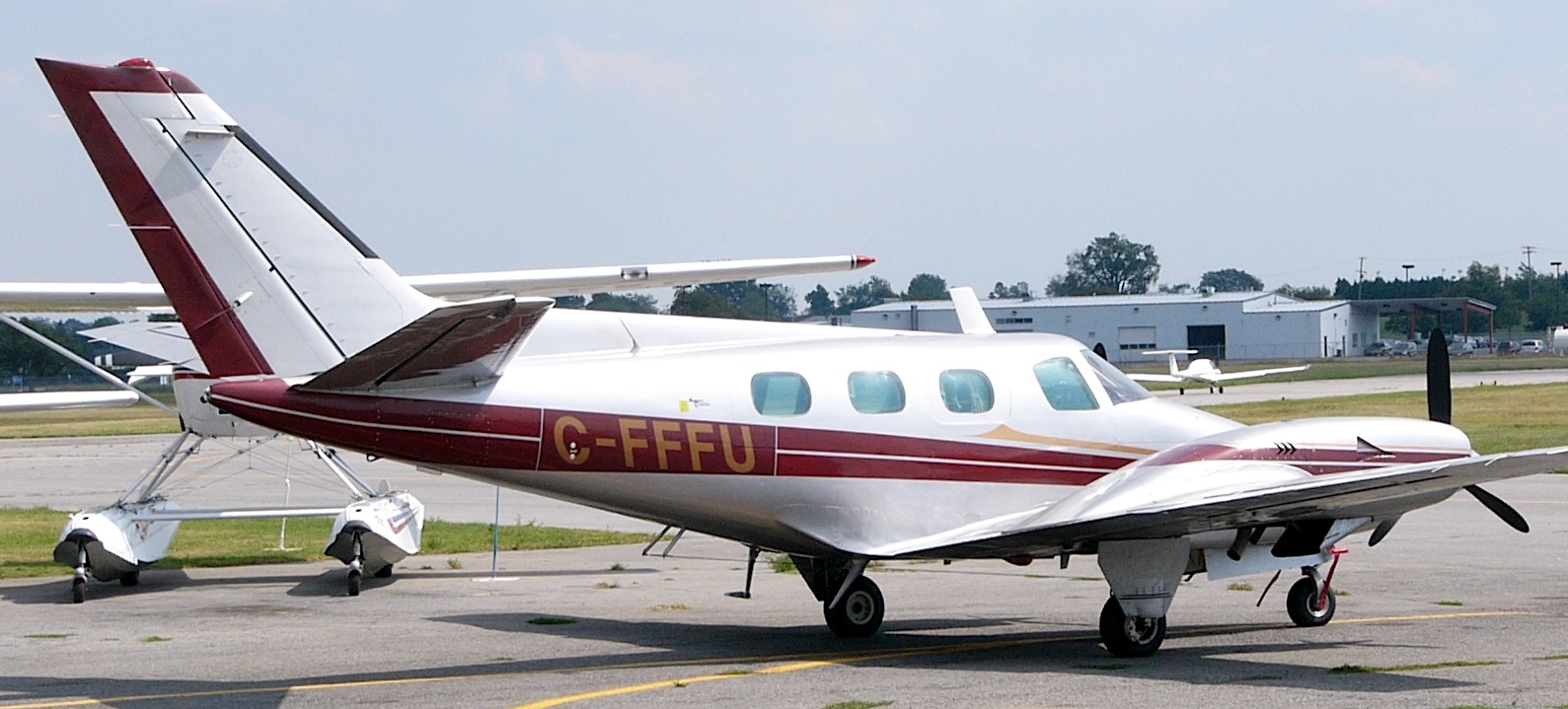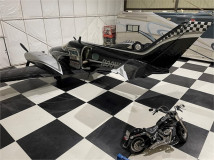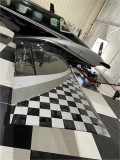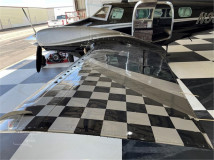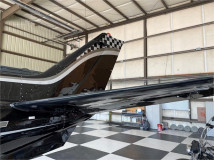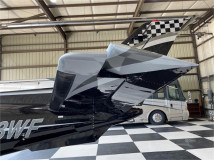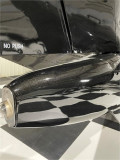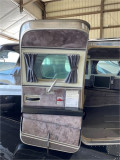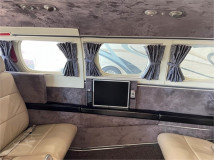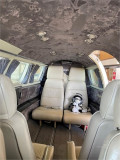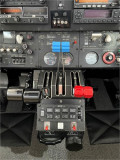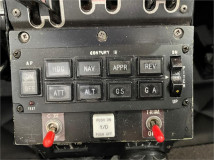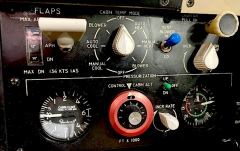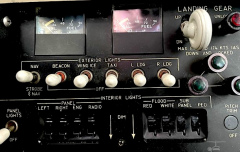Why a Duke?
Having flown the Red Baron for five years, I had fallen in love with speedy access to any place in the U.S. But I suffered the same itch as anyone who has ever owned a boat … or a house … or a plane…. For a few dollars more you can upgrade to [insert your fantasy here].
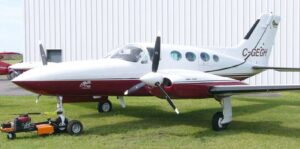
Back when I was thrilled to afford even an hour of aircraft rental, I had occasion to simply sit in a Cessna 421, an upscale executive twin. My envy was palpable – oh that I could one day fly an airplane like this.
Fast forward fifteen years – I was searching for just such a dream machine. My new love was the Beechcraft Duke. Like the Cessna I had so adored, its luxuries included plush seats with a folding desktop, air conditioning, and best of all, pressurization. I could fly above bad weather … in quiet pressurized comfort … without having to breath supplemental oxygen (often described as sucking on a dirty sock) and so could my passengers.
Plus the Duke was – and still is – sexy. It looks like it’s at warp speed just sitting on the ramp. The only civilian airplane that holds a candle to it is the Lear Jet. They both look like Ferraris without even moving. And, in the air, they both live up to their image.
Shopping
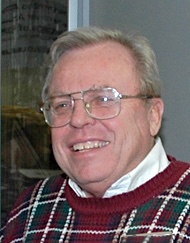
Like searching for a new home, I needed a knowledgeable rep. And in 1993, nobody knew Dukes better than Ron Knudsen of Willowbrook Air Associates in Denver. I think his notebook included the complete history of every Duke ever made.
Within a day Ron called about a beauty – low time, beautiful colors and interior. The seller agreed to fly it to our airport for inspection. Watching it land and taxi to the hangar, I felt like a five-year-old on the first day of school. Climbing in, I even discovered a snack bar tucked between the seats. But the tail feathers (rudder and elevators) looked a little odd. Closer inspection revealed damage that had been poorly repaired. This was not the plane for me. I paid for the gas and sent him on his way. Felt kinda sorry for the owner; he had spent a ton of money for a bad repair job.
Ron wasted no time. A few days later he found one that looked even better. And for less money. The owner left it with Ron to inspect and everything looked good.
This was the one: N33WF, Serial number P-168.
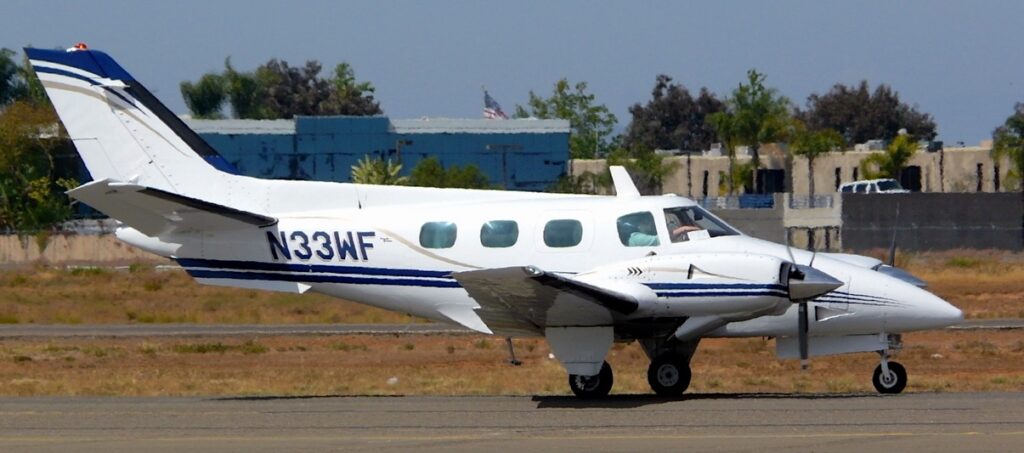
Bring it home
Although by this time, I had logged more than 1500 hours, the Duke was much more complex than anything I had previously flown. Prudence and the insurance company required additional instruction before I flew it by myself. Fortunately, a Duke expert, Dale Lockart, lived in my own backyard and was free to fly out to Colorado and check me out in it.
The first challenge I faced was simply getting into the pilot’s seat. Planes I had previously flown all had a door right next to the pilot seat. Not so in this cabin class limousine. There was one door and it was in the back of the plane. From there, I had to work my way through an aisle and shoehorn myself into the front left seat. I couldn’t imagine how Dale was going to get into the seat next to me. His medical certificate may have listed his weight as 320, but I don’t believe reality was a pound less than 400. Yet he simply glided in – the result of practicing the maneuver hundreds of times, I suppose.
Startup was familiar – engines on the Duke were the no different than those I had been starting for the past five years. That’s where the familiarity ended. We immediately turned on the air conditioning – no sweaty brows for passengers in this plane. Then we went through a long and deliberate preflight checklist as I searched for all the switches and gauges that were completely alien to me.
Finally we headed for the runway. It was quiet. The pressurized hull was so solid that the engine roar of the Red Baron was reduced to a low, reassuring hum. Was this an airplane or had I been transported to heaven?!
With the added range of the Duke, we easily flew from Denver to Palwaukee in a little over 3½ hours. If I was infatuated with Whiskey Fox when I first saw it, I was head over heels when we landed.
The learning begins
The trip from Denver was only an introductory lesson – enough to get the plane back home. Before my next flight, Dale spent two days in a classroom teaching me about all the new systems.
In the Red Baron, I flew at high altitude. But other than needing an oxygen mask, it was pretty much the same as what I had been doing for ten years and a thousand hours. The pressure inside the plane was the same as the air outside. And if the plane went higher, so did the flyers … at the same rate.
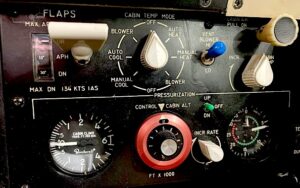
Not so in the Duke. Before there was only altitude. Now there was airplane altitude AND people altitude. And they were managed separately. People’s ears become uncomfortable, possibly even injured, if they descend too fast. But by turning some magic dials, I could go into a nosedive while passengers glided down a gentle slope at 300 fpm (feet per minute). They might notice a little more wind noise.

Limousine comfort didn’t stop with pressurization. Cabin temperature was controlled by set-it-and-forget-it dials. Pretty impressive for a plane built more than 50 years ago.
It even had a lighting control panel with fifteen switches and dials.
The instruments and radios are pretty much the same as they were when I was flying twenty years ago. The radios were functionally the same as the Red Baron, but all different brands and dials to do the same tasks. And in aviation, there are a multitude of different dials and buttons to master.
Checkout in the plane
Having just flown from Denver, I had the general feel of the plane. But a full check out demanded much more. It involved practicing many of the same maneuvers learned Aviation 101 – Private Pilot: steep turns, slow flight, stalls, etc., followed by landings under varying conditions. Private was followed by Aviation 201 – Instrument Pilot: approach and landing without being able to see anything until about a half mile from the end of the runway.
Although the maneuvers and procedures were the same as what I had practiced, the Duke traveled twice as fast and weighed five times as much as a beginning trainer. Fortunately Whiskey Fox flew a lot like the Red Baron I had been flying regularly for five years and we were able to complete the flight checkout in one very demanding day.
Dale also showed me a few new things that weren’t in the books.
Cruise climb
Knowing that altitude is gold, pilots climb at a maximum rate right after takeoff to “put some in the bank.” Above a thousand feet or so, they transition to cruise climb – a more gentle climb that’s faster, quieter and easier on the engine – until they reach cruising altitude.
Dale taught me how the Duke could cruise climb like a jet – a lot faster and still climbing. “Set the airspeed about 10% below level cruise speed and hold it there.” Sure enough, the speed was great and in short order, the climb rate came back up. Wow! I gained forty knots for the duration of every climb. And since I flew at high altitudes, I enjoyed that extra speed for 20 minutes or more.
Circling approaches
Occasionally visibility is low and the only instrument approach available is to a runway not suitable for landing. The solution is a circling approach – follow the approach until the airport is visible, then join the traffic pattern for a better runway. If you lose sight of the runway, immediately climb back into the clouds and go somewhere else – a missed approach procedure. Considered too risky by some pilots … or their bosses.
Dale emphasized the importance of visual contact with the runway, but he pointed out that a conventional traffic pattern with a nice long established final approach was a sure way to lose it. Instead stay in very close and complete the final turn to the runway just before touching down. I practiced it on a clear day. It works and usually avoids the dreaded missed circling approach.
Ready
A week after Dale blessed me to go on my own, I spent five hours flying around to approach and land at four different airports in our area. Within the next month I was off to a Creative Painting convention in Las Vegas. Then to visit the editor of Painting Magazine in Florida.
Fly-By-Knight Airline was on a roll. And I was living large.
Epilog
I recently discovered that Whiskey Fox was given a major makeover. Here is what it looks like today:
* * *
New types: Beechcraft A-60 Duke
New ratings: None
Total flying time to date: 1,575 hours
Questions or comments? Please leave a reply below. I’d love to hear from you.
Or contact me directly at grandpalylesnotebook@gmail.com
